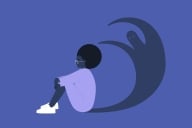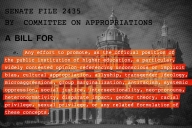You have /5 articles left.
Sign up for a free account or log in.
Russell Swagger, president of Lac Courte Oreilles Ojibwe College in Wisconsin, knew the institution needed a better way to provide mental health services to students and employees when it started to become apparent that the challenges posed by the COVID-19 pandemic were hurting students emotionally.
Students and faculty at tribal colleges like his were under a lot of strain. Many had to juggle academic responsibilities while caring for children no longer attending school or daycare or taking care of relatives sick with the coronavirus. Some students lost jobs, and others had to get jobs or work more hours to help support parents or siblings who were laid off. Many families lost loved ones to the virus. On and off campus, the tribal community was struggling, and college administrators knew they had to help.
“With COVID, we’ve seen an uptick in overdoses, domestic violence situations, suicide attempts and completions,” Swagger said. “All of these things are just becoming more intense and happening more often. It’s like people just can’t get a break. People start grieving one thing -- and then another thing happens and another thing happens.”
The college launched a new, free teletherapy service for students and faculty members to access mental health services at all hours of the day and night. The college partnered with a higher education mental health platform called UWill, which uses artificial intelligence to connect users to an available counselor from the platform’s network.
“Teletherapy, I think, is a good way, as an intervention, to be able to at least get in there when something is immediately happening and reduce the chances of somebody doing something serious to harm themselves or somebody else,” Swagger said.
Tribal colleges across the country are working to beef up their mental health services as students wrestle with the myriad consequences of the pandemic. Native American communities faced disproportionately high COVID-19 infection and death rates, job losses, and financial strains during the global health crisis. Students living in remote regions with notoriously poor broadband access often struggled with online learning and could no longer access the academic and social support services they got on campus.
Sandra Boham, president of Salish Kootenai College in Montana, said her college has tripled its budget for mental health services since the pandemic began, introducing teletherapy services for the first time last year and hiring more in-person therapists.
“Our appointments are full -- all the time,” she said.
The pandemic took a toll on students’ mental health nationwide, exacerbating already-high rates of depression and anxiety. A fall 2020 study from the Healthy Minds Network found that almost 80 percent of students indicated they “need help for emotional or mental health problems such as feeling sad, blue, anxious or nervous.” Meanwhile, only 29 percent of respondents received mental health therapy in the past year.
The American Indian Higher Education Consortium (AIHEC) conducted a survey of 486 students returning to tribal colleges in fall 2020, which found that nearly a quarter of students who could meet their mental health needs before the pandemic were no longer able to do so during the pandemic. Thirteen percent of students said they were unable to meet those needs even prior to the pandemic.
Tribal college leaders say a lack of widely available and accessible mental health care on reservations has compounded the emotional struggles students face.
“The number of deaths in Indian communities throughout this pandemic, it’s been pretty staggering,” Boham said. Students are “navigating sick family members and dying family members and their academic studies and childcare issues. It’s a huge pressure on people.”
The COVID-19 mortality rate for Native Americans in Montana was 3.8 times that of white residents between March and November 2020, according to a study released by the Centers for Disease Control and Prevention in April. Nationally, there have been at least 8,074 COVID-19 related deaths among Native Americans, according to CDC data (although the agency says the count is incomplete).
“Every person here on campus has been affected by a loss,” said David Yarlott, president of Little Big Horn College in Montana.
Yarlott said grief has been widespread and overwhelming among students and employees, and COVID-19 safety protocols stymied some of the traditional ways the college supports people mourning deaths. Usually, if a family member of a student or employee passed away, the college would hold a “wiping of the tears” ceremony where campus employees share a meal with mourners and tribal elders pray for them. The college livestreamed two ceremonies with limited attendance -- one in May and one in August -- to mourn collective losses, but the videos didn’t get many views and failed to offer the “closure” of individual, in-person ceremonies, he said.
Cheryl Crazy Bull, president and CEO of the American Indian College Fund, said the loss of these communal rituals and supports is an added challenge for tribal college students. Many are facing obstacles posed by the pandemic without “the ceremonial and social environment that we as Indigenous people have as our normal way of living.”
Tribal college students, and Native American communities in general, also lack access to mental health professionals and are hesitant to seek out the few who work on reservations because of the stigma related to mental health treatment, Swagger noted.
A poll of 200 Native American adults in July 2021 -- published by the National Council of Mental Wellbeing, an association focused on access to substance use treatment -- found that 45 percent of respondents reported having increased mental health challenges over the last year, but only 24 percent received any kind of mental health services over that period.
Lac Courte Oreilles Ojibwe Community College previously offered the services of two mental health professionals on campus. The counselors were employed by a local tribal wellness center and divided their time between the college and the center, with limited hours on campus. They returned to the center full-time after the pandemic was declared and the campus went remote. Students could go to the center for counseling, but the center is about five miles from the main campus and a two- or three-hour drive from the college’s four satellite campuses, Swagger said.
“In tribal communities, there’s not enough mental health workers,” he said. “They’re not readily available. There’s not enough educated workers to meet the demand.”
Compounding the problem is the reluctance of students to go to tribal wellness centers for mental health services because they are ashamed of needing mental health care and don’t want others to know they’re struggling. Tribal communities can be small and interconnected; keeping things private can be challenging. Patients often know the people working at the centers and might feel “embarrassed” to confide in them about their problems.
Yarlott said about eight years ago, Little Big Horn College partnered with the Indian Health Service to bring mental health professionals to campus, but students wouldn’t go see the counselors. The students told college leaders that they didn’t want their peers to see them entering a therapist’s office.
“Nobody was utilizing it,” he said. “They didn’t want their friends or community members knowing they may have a mental issue or what have you. We found out they didn’t want to be seen as having a problem.”
Swagger believes teletherapy can alleviate some of those concerns. Even if some students struggle to access the service if they live in remote areas with unreliable internet access, at least more students will be able to promptly speak with licensed counselors with some privacy.
“At least with this service, they’ll be able to sit in private in a quiet area somewhere and dial up these services and have access and not have to have all the issues associated with stigma and everything else that comes along with accessing those kinds of services,” he said.









